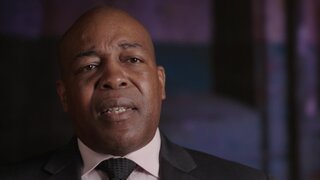Create a free profile to get unlimited access to exclusive videos, breaking news, sweepstakes, and more!
He Had ‘Skeletons In His Closet’: Married NYC Sanitation Worker Shoots Pregnant Ex-Girlfriend
Roscoe Glinton's first wife had been murdered. Then, his ex-girlfriend Lisa Eatmon was found dead in the Hudson River. What was happening?
For Lisa Eatmon, a divorced single mom with a 12-year-old daughter, life in Brooklyn was about to be filled with new joys. She was a month away from having a baby boy.
But on April 3, 2005, Eatmon was found floating in the Hudson River off a pier in the Chelsea neighborhood. She and her unborn son were dead, reported the New York Post.
At the time police faced tough questions. “We don’t know if it was accidental,” Tony Vega, a retired NYPD detective, Manhattan South Homicide Squad, told “New York Homicide,” airing Saturdays at 9/8c on Oxygen. “We don’t know if it was suicidal.”
The victim’s family adamantly ruled out suicide for Eatmon, a Toshiba repairwoman who’d served a lengthy term in the Army. She had recently moved from Philadelphia to New York City.
Eatmon’s autopsy revealed that she had been shot once in the back of her head. A small bullet wound was found beneath her braids. Detectives now knew they were chasing a homicide and pieced together Eatmon’s final hours. Her daughter said she and her mom said good-night to each other between 1:30 and 2 a.m.
Eatmon’s car was parked outside their home. How had she gotten from Brooklyn to Manhattan? Police had the car towed to the crime lab to look for evidence — hair, fibers, fingerprints — but the results yielded no leads.
Investigators sought to find the father of Eatmon’s unborn child. Her intimates believed he was Roscoe Glinton, then 42, who’d ended the relationship around the time she got pregnant. Eatmon was OK with that, loved ones said. Her attitude was that she’d raised one child alone and could raise another on her own since she was surrounded by family support and love.
Vega called in Glinton, a sanitation worker, for an interview. He handed him a cup of water before questioning. Glinton claimed the night of Eatmon’s murder he was out at a bar with sanitation buddies until around 4 or 5 a.m. The garbage truck driver told Vega that he was uncertain he was the unborn child’s father because Eatmon, he alleged, was seeing other men.
Glinton left the interview but he was unaware, Vega told producers, that he’d left something behind: his DNA on the cup.
But was there another man in Eatmon’s life? Police stationed at her apartment got the answer when he walked up to them and handed them the keys to her car. The man acknowledged having a casual sexual relationship with Eatmon, and he said that he’d borrowed her car and was bringing back the keys when he saw the police. Eatmon’s family knew the man and the arrangement he had about using the car.
He was one of the last people to see Eatmon alive, making him a suspect, said Vega. But between a solid alibi and DNA evidence he was eventually cleared.
Investigators at the 10 Precinct turned to Eatmon’s phone records for clues They found that on the night she was killed, a 3 a.m. call was made to her from a gas station pay phone not far from her apartment. It was the last call she ever received.
There were no surveillance cameras to reveal the identity of the caller. But when NYPD detectives tapped into other New York City law enforcement agencies for fresh leads, they caught a break.
The DEA was working on its own case and was staking out the block where the bar Glinton had gone the night of the murder was. Glinton had said he’d arrived shortly after midnight and stayed for hours. DEA footage told another story. It showed that Glinton had left the establishment much earlier than he’d claimed. That punched a hole in Glinton’s alibi. Where had he gone?
Detectives also learned Glinton was married and spoke to his wife. She stood by her husband, insisting he was not involved. She also revealed that she had called him over and over the night of the murder. He never picked up her calls. When he got home in the morning he said the bar was noisy so he didn’t answer.
As detectives looked to Eatmon’s inner circle for leads, one revealed that Glinton had “skeletons in his closet,” said NYC journalist Janon Fisher.
Deborah Glinton, his first wife and the mother of his three children, had vanished from their home in Orange County, New York seven years earlier.
She worked as a dental assistant, and her office called the police to report her missing. Glinton denied any involvement in her killing, even after Deborah’s remains were found in 2001 along the New York State Thruway and verified through dental records.
In her diary, Deborah wrote about her husband’s abuse, according to the New York Post. Her cause of death was never determined and her murder remains unsolved. Glinton subsequently moved with his kids to Brooklyn.
NYPD detectives focused on Glinton’s phone records to trace his whereabouts using a trail of digital breadcrumbs. Pings showed that he was in Eatmon’s neighborhood when she picked up the 3 a.m. call. The pings also marked him at a sanitation depot in Chelsea close to where Eatmon’s body was recovered from the Hudson River.
Glinton’s coworkers also gave detectives a fresh lead. They reported that they’d seen him painstakingly cleaning an outdoor patio area, behavior that was out of character. A portion of the deck was removed and tested for Eatmon’s DNA — and the analysis came back a match.
On April 22, two weeks into the investigation, Glinton was arrested. At the trial, the prosecution argued that Glinton wasn't keen on providing for another child, especially one he repeatedly denied was his, according to Boyce.
However, the district attorney told the court that Glinton’s DNA was a 99.9 percent match to the unborn baby.
On November 21, 2006, Roscoe Glinton was convicted of second-degree murder. He was sentenced to 25 years to life.
For more on this case and others like it, watch “New York Homicide,” airing Saturdays at 9/8c on Oxygen or stream episodes here.























